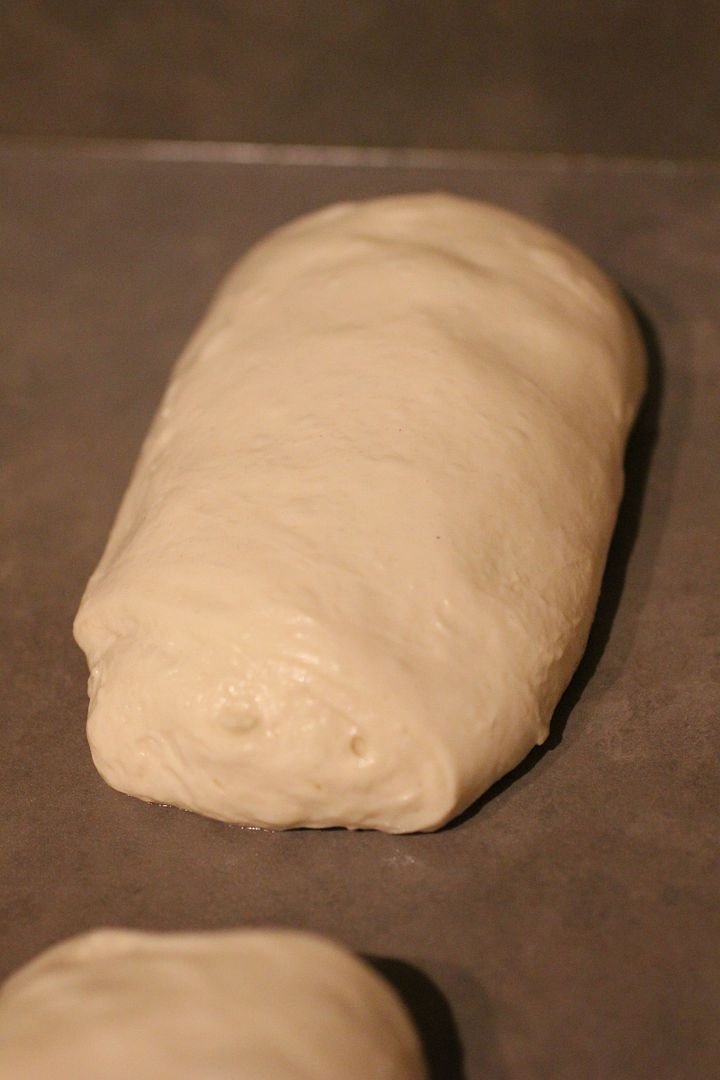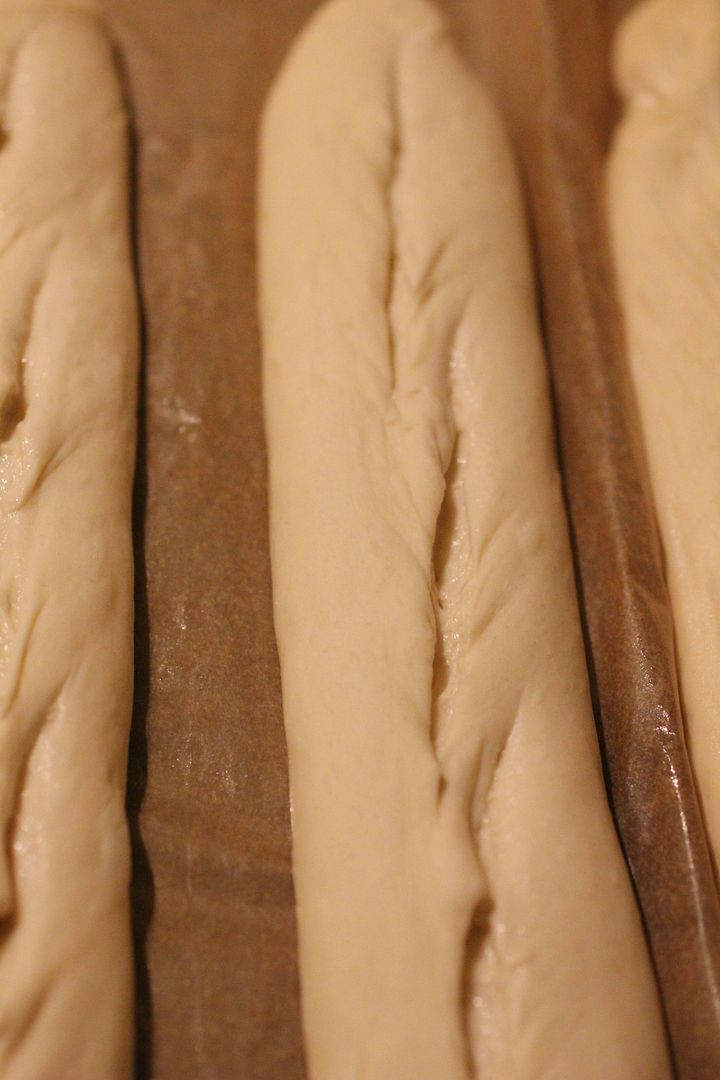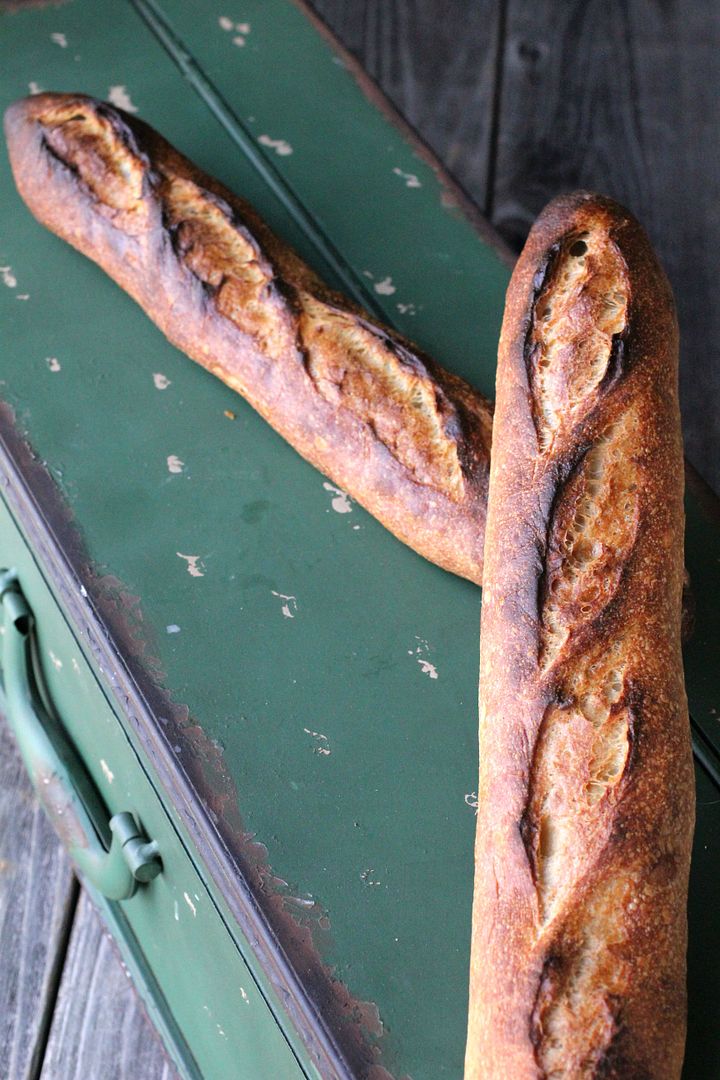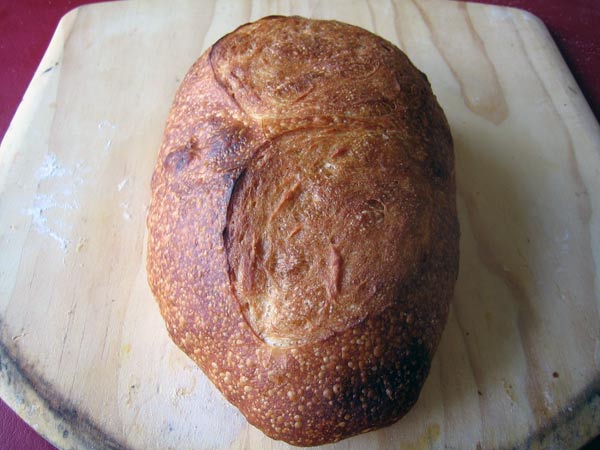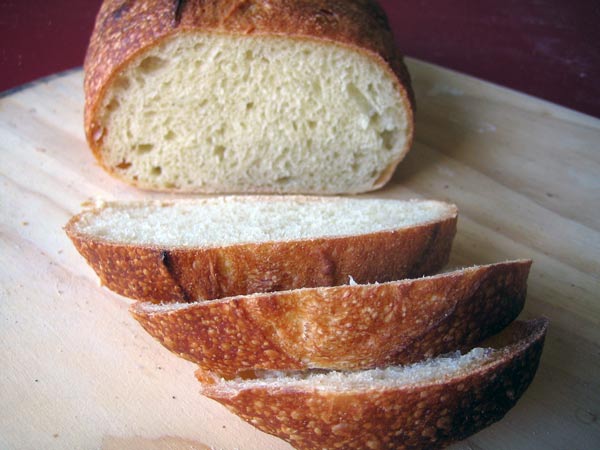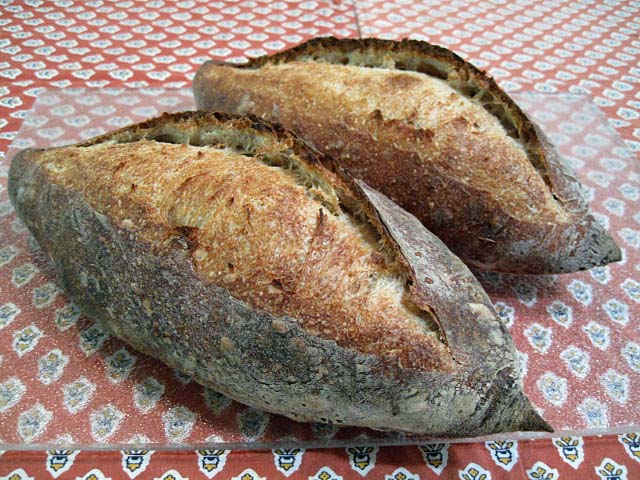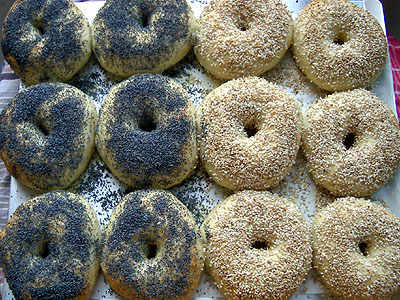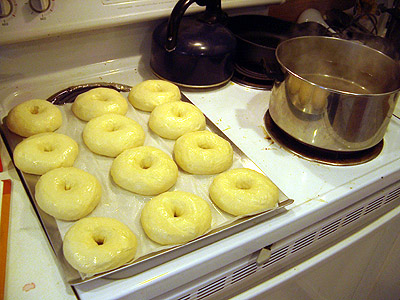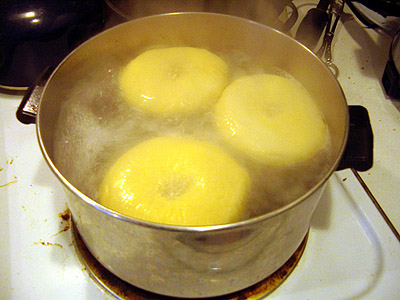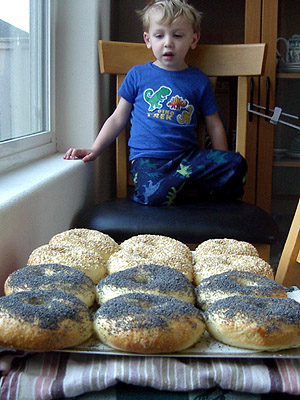
Croissants - in Buttery Heaven!

When my husband decided to open up a furniture store in Portland, ME, he found a big old garage in Fore Street. After spending a month with scrubbing, painting and cutting new panes for each of the high windows, he turned the dark and dirty place into a beautiful, light space, to showcase his contemporary furnishings.
Eventually Richard Parks Gallery moved to Commercial Street, and the first floor of the old store became Fore Street Restaurant, one of Portland's foodie temples.
The souterrain was turned into a bakery, and, instead of housing French sofas and bistro tables, it's now home of Standard Baking Co., maker of the best French breads and pastries in Maine!
 |
| Richard Parks Gallery on Fore Street in the early Nineties |
Whenever we visit Portland, we get Pain au Levain, Seeded Fougasse, Croissants, or, on Fridays, Rugalachs.
Last time we came into the bakery, I saw a pile of books: Standard Baking Company had published "Pastries" with many of their recipes, including those of the croissants and rugalachs we were just about to buy. Of course I didn't hesitate one second, grabbed one of the little books, and, while driving home and munching on a walnut filled rugalach, studied the recipes.
Though I bake (and sell) lots of breads, I have little experience with French baking, and couldn't wait to try making one of those mouthwatering pastries myself.
I was also wondering whether Alison Pray and Tara Smith had dumbed down their formulas to make them "everybody's darling". Or, jealously guarding their secrets, changed them so that the home baked pastries would never taste the same as their professional counterparts at the store (try finding the original Sachertorte in Hotel Sacher's pastry book!)
 |
| Worth every penny! |
To my utter delight neither was the case. Every piece of pastry I made so far was outstanding - and tasted as good as its sibling at the bakery. (No, I don't get a kickback for my gushing!)
Croissants, with their multi-layered, buttery dough, are the gold standard of pastry baking. I had made them only once before. Those had turned out quite nice, and I was curious how the Standard Baking ones would compare to them.
I found the formula easy to follow, with clear, detailed instructions and explanations for every step of the way. Involved as the process is, it's not rocket science, and you really can do it at home!
You have to plan ahead, though, because you'll achieve your best results when you allow the dough sufficient time to rest. As with most of my breads, time and the refrigerator are your friends, achieving three important goals: relax the gluten (readying the dough for the next turn), keep the butter cold (preventing it from seeping out) and develop the taste.
Therefore, make yourself familiar with the whole procedure before you start! This is your schedule for the 3-day process (no worries, the actual hands-on time is much less!)
| Pure buttery, flaky goodness! |
TIME PLANNER
DAY 1 (Mixing the dough)
Hands-on time: 20 minutes mixing Resting time: 1 hour plus 1 night
DAY 2: (Laminating the dough)
Hands-on time: 2 to 2 1/2 hour Resting time: 2 hours plus 1 night
DAY 3: (Shaping and baking)
Hands-on time: 30 minutes Resting time: 1 1/2 to 2 hours
If you don't want to use all the dough for regular butter croissants, use part of it for Sticky Buns, Pain au Chocolat or Ham & Cheese Croissants. You can also freeze the laminated dough up to 10 days, thaw it in the refrigerator overnight before baking.)
And if you have leftovers, recycle them into utterly delicious Almond Croissants!
BUTTER CROISSANTS (12) (adapted with Alison Pray's permission from Standard Baking Co. "Pastries")
Dough
630 g all-purpose flour (4 1/2 cups)
7 g instant yeast (2 1/4 tsp)
50 g sugar (1/4 cup)
14 g salt (2 1/2 tsp)
28 g unsalted butter*) (2 tbsp), cool, cut in pieces
186 g water, at room temperature (about 70ºF) (3/4 cup)
186 g milk, at room temperature (about 70ºF) (3/4 cup)
Butter Roll-In
280 g/10 oz unsalted butter*), chilled
Egg Wash
1 egg
2 tsp. water
1 pinch salt
*) If you have the chance, get European style butter with a higher percentage of fat (like Cabot's European style butter or Plugra)
DAY 1
For the dough, whisk together flour, yeast, sugar and salt in a large bowl. Using your fingertips, rub butter into dry ingredients until it is evenly distributed and coated with flour mixture.
| Rubbing the butter into the dry ingredients is easy |
Using a stand mixer with dough hook: Combine water and milk in mixer bowl. Add dry ingredients on low speed and incorporate for 3 minutes, scraping down sides of bowl as needed.
Increase to medium speed, stopping mixer after 2 minutes to check consistency of dough. It should be medium-soft. (If it feels stiff, add more water, a tablespoon at a time.) Resume mixing for 2 minutes more. Dough will not be completely smooth, but hold together. (Don't over-mix, you don't want the dough to become tough!)
Using a food processor: Pulse for about 2 minutes, or until dough comes together in a ball. (Don't over-mix, otherwise dough becomes more difficult to roll out, and result in less tender croissants.)
Place dough in lightly oiled container, turn around to coat with oil, cover, and let rise in a warm spot (ideally 75ºF) for about 1 hour, or until it has grown by about half.
| The dough has risen 1 1/2 times its original size |
Transfer dough to a lightly floured work surface and pat it into a rectangle about 2 inches thick. Wrap it in plastic and seal it well to prevent it from escaping when it rises. Refrigerate dough overnight (or at least for a minimum of 4 hours.)
(I placed the dough on lightly floured cutting board, sprayed it lightly with baking spray, put the whole thing first into an unscented garbage bag, and then in the fridge.)
DAY 2
About half an hour before rolling out the chilled dough, prepare butter roll-in: cut cold butter into large chunks, and place them in mixer fitted with dough hook. Beat butter on medium speed until completely smooth and pliable, but not warm (about 3 minutes.)
(You can also pound the butter with a French rolling pin until it is flat and pliable, but the mixer works great.)
| After kneading the butter is pliable but still cold |
Transfer butter to a piece of plastic wrap or parchment paper. Press it into a 6-inch square, 1/2 inch thick. (I measured and marked parchment paper at 6 inches, and folded it into a square, then closed it with the butter inside, and pressed on the package until the butter filled the edges.)
Chill butter square in refrigerator for about 15 minutes (it should be just firm, but not hard.)
| Folded parchment paper helps pressing the butter into a square |
And now the fun starts: you are about to create something absolutely wonderful, a tender, buttery, multi-layered (laminated) croissant dough.
Room temperature and work surface should be on the cool side, and each step should be done as quickly as possible, to prevent dough and butter from getting warm. Put everything you need (flour for dusting the work surface, roller pin, brush for excess flour, and ruler for measuring) within easy reach.
| The butter square covers half of the dough rectangle. |
If the chilled butter feels too firm, take it out of the fridge a few minutes before using. Dust work surface lightly with flour. Remove dough and butter block from refrigerator. Roll dough into rectangle twice the size of the butter square: 12 x 6 inches. Brush off excess flour from top of dough. Place butter square (unwrapped) on one half of rectangle, so that edges are neatly stacked.
Fold other half of dough over butter, and press open sides together to seal butter in. Lightly re-flour work surface, if necessary, and roll out dough rectangle into a square, about 1/2-inch thick and twice as long as it is wide (the long side should be facing you.) Brush dough surface to remove loose flour.
| Roll out dough into rectangle twice as long as it is wide |
Fold dough lengthwise in thirds like a business letter, always brushing any loose flour from the surface before you fold: first fold left third over center, then right side over left. Using a bench knife, straighten and square edges, so that layers are neatly stacked. Congratulations! You just made your first turn (aka envelope fold.)
Wrap the dough "envelope" in plastic wrap and refrigerate it for 45 - 60 minutes, so that you and the gluten can relax and cool down. In the meantime, clean your work surface from any remaining bits of dough, and dust it again lightly with flour.
 |
| After its workout the dough needs another break in the fridge |
Unwrap cooled dough and place it on work surface, the long, folded side facing you. Roll out dough as before into a 1/2-inch thick rectangle. Fold it again in thirds, always brushing off excess flour between folds. The second turn is done! Re-wrap and re-chill dough again for 45 - 60 minutes.
Now you're already a pro, and know how to handle the third and final turn. Unwrap, roll out, fold, and use the brush in between! You don't want flour to keep the layers from adhering.
| Brushing off any flour from the top of the dough is important |
So, that's it for the day, wrap your (beautifully laminated) dough in plastic and place it in the freezer. Before you go to sleep, take it out, and put it in the fridge so that it can slowly thaw overnight. (Or, if your mouth waters too much, and you need to bake it the same day, give it at least 2 hours chill-out time before shaping.)
TO MAKE AHEAD: You can also freeze the dough up to 10 days, thawing it in the fridge overnight before baking.
DAY 3
Line 2 baking sheets with parchment paper. On a lightly floured work surface, roll dough into 12-inch x 25-inch rectangle (1/4 inch thick.) Re-dust with a little flour, if needed, to prevent sticking. If dough springs back and is difficult to lengthen, let it rest a few minutes, before you continue. When desired length is reached, trim and straighten narrow ends with pizza wheel or chef's knife.
 |
| A same size piece of parchment paper with markings helps with the cutting |
Cut rectangle into long, skinny triangles, 4 inches wide at base and 10 to 12 inches long on sides. (It's easier if you cut parchment paper into a same size rectangle, and measure and mark bases and tips of triangles on it. Place paper over dough, and then mark dough in the same way with little incisions.)
Make a 3/4-inch incision in the center of each triangle base (this notch helps to create the desired length in the final shape.)
To shape each croissants, pick up a triangle, holding base edge with one hand. With the other hand about 1 inch from base, pull dough gently to lengthen it slightly, without causing any tears. Place triangle down again, base towards you, and gently but firmly roll it up towards the tip. (If done properly, you should have 6 to 7 tiers.)
Leftover dough scraps: Place cut off half-triangles from both edges side by side, pinch the middle seam together, put any other small scraps on top, and roll this patchwork triangle up, too. It will be a little "malfatti" (badly made) as my half Italian spouse calls it, but nothing of your precious dough will be lost.
| The triangles get a notch at the base to make lengthening easier |
Put shaped croissants on prepared baking sheets, evenly spaced, the tips should be tucked underneath.
For the egg wash, whisk together egg with water and salt in small bowl until smooth. Brush croissants lightly with egg wash, carefully avoiding open edges, so that the egg can't glue them together and prevent tiers from rising. (Refrigerate remaining egg wash for the second application.)
The croissants need to proof for about 1 1/2 to 2 hours. Place baking sheets in the (unheated!) oven, then put a pan with hot, steaming water on the bottom to provide the ideal rising environment: humid, to prevent a skin from forming, and warm, but not too warm - you don't want the butter to melt, resulting in less flaky, greasy croissants.
Half an hour before baking, remove proofing croissants from oven. Position racks in upper and lower thirds, and preheat oven to 430º F.
Cover croissants, and continue to let them rise, until they have almost doubled in size, and dough springs back slightly when pressed gently with a finger tip, but the dimple should remain visible. Each tier should still hold its distinct shape. (Check croissants frequently after the first hour of rising, if they overproof, they will have loose their flakiness and have a bread-like structure. The room temperature should not be too warm.)
| Proofed croissants. The "malfatti" on the upper right is not much different from the others |
A few minutes before they go into the oven, brush risen croissants again with a thin coat of egg wash, carefully avoiding the edges (you don't want to screw up now!)
Bake croissants for 10 minutes, then quickly rotate baking sheets from top to bottom and from front to back, for more even browning, taking care not to leave the door open too long. Continue baking for another 4 - 6 minutes, until they are evenly baked, with deeply browned, crisp edges.
Remove sheets from oven, and transfer croissants to wire rack, to cool a bit. They are best when eaten while still warm, or shortly after baking.
If you cant eat all of the croissants right away, you can wrap them individually in plastic wrap, and re-crisp them at 375ºF for a few minutes.
OR YOU TURN THEM INTO HEAVENLY ALMOND CROISSANTS!
| There is no such thing as stale croissants when you recycle them into these! |
Submitted to YeastSpotting








